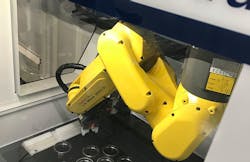Today’s Advanced Grinding Automation Now Comes Standard
Global demand for manufacturing robotics and automation continues to climb as shops look for ways to increase productivity, precision and efficiency in the face of skilled labor shortages and growing trends toward high-mix, low-volume production. Studies show that for shops with grinding equipment, installing an automation system on one machine can increase productivity by as much as 33 percent per shift and reduce the need for additional manpower by 13 percent, yielding $1.5 million in labor savings and nearly $500,000 in productivity gains over a 15-year period.
Most shops want to use automation to increase productivity, not merely to offset the dwindling pool of experienced operators. However, the automation technology must match the types of grinding machines these shops use. Both cylindrical and tool-grinding-type machines, for instance, require an uninterrupted supply of workpieces without slowing or stopping the grinding operations to load or unload and without waiting on the automation to supply those parts. In the past, automation that met those needs involved large capital outlays for hardware and custom software, but new developments in standardized automation have produced options that fulfil today’s requirements and budgets for more potential applications.
When it comes to automation integration, more shops opt to integrate automation systems on their own or rely on their grinding machine OEMs to perform the task. OEM-designed automation systems that integrate directly into grinding machines offer the full advantages of technology created, installed and warrantied for each specific piece of grinding equipment. For one OEM, UNITED GRINDING, the importance of integrating automation on its equipment led it to set up an in-house Automation Systems department. That department's understanding of how customers want to implement automation on cylindrical and tool-grinding machines also propelled the design of a standard, fully integrated commercially-available loading system called flexLoad. Such a standard, integrated loader takes on tedious, repetitive, manual tasks and frees employees for other responsibilities, while delivering flexible performance at a price point more in line with what today’s shops want to spend.
Most shops expect automation to provide short cycle times, allow parts to be removed for inspection and separate out the rejects, all without interrupting the machine or altering its internal working temperature. Along those lines, the flexLoad system maintains a load/unload cycle time of six seconds and can include statistical process control (SPC) for parts inspection and handling of rejects. An operator can open any of up to three completed-parts drawers while the grinding machine continues to run at full speed.
Automation systems can offer long lists of value-added options to increase their flexibility, but many shops only need specific cost-contained additions to standard feature sets. For example, in-use chucks and tooling must stay free of coolant, and automation can assist in these maintenance tasks, along with gauging and tracking parts, but these extra steps must not increase cycle time unduly. To achieve these objectives, UNITED GRINDING added gauging and barcode scanning to its flexLoad system, along with an air nozzle on the end of its robot's arm to clear off coolant.
Automated equipment must run continuously and quickly, preserving workplace safety while maintaining the pace of production. Because OEMs integrate their automation technology directly into their grinding machines, they can offer built-in features tailored to preserve both speed and safety. Full-system enclosures, for instance, offer high levels of worker protection, but front-door access on a grinding machine slows cycle times compared to other options. For flexLoad, UNITED GRINDING opted for a full-system enclosure, incorporating a flanged side door between the machine and the robot, one that won't open without an explicit request-for-entry signal from the operator. Compared to front-door access, the flexLoad design cuts six to eight seconds from overall cycle time.
Because ID and OD cylindrical machines set up as mirror images of each other, OEMs must build separate versions of their integrated systems to accommodate both types of equipment. What looks like the simple task of inverting a design actually involves creating a completely different system optimized for a process-specific machine. After UNITED GRINDING created an OD version of its flexLoad system, it engineered a fine-tuned ID implementation that fit on the left side of the machine instead of the right.
Unlike third-party add-on automation systems, OEM implementations such as flexLoad can take advantage of unique opportunities to optimize integrated standard loaders. Even well-designed equipment needs routine maintenance, and integrated systems can make their vital parts easy to access without aftermarket alteration of the grinding machines themselves. To make flexLoad pneumatics simple to service, for instance, UNITED GRINDING gave the system a single metal panel as an access point.
Ultimately, the most valuable aspect of an automation system is its flexibility and adaptability. OEMs who research customer needs and implement features to address relevant requirements can produce automation systems that offer significant value. UNITED GRINDING created flexLoad so shops could change end-of-arm tooling to work with different workpieces and switch to radically different jobs, all within a system ideally suited to making diverse types of parts in high-mix, low-volume scenarios. Although UNITED GRINDING Automation Solutions can design custom systems for any of the company’s eight machine brands, it built the standard flexLoad system for many STUDER models of OD and ID grinding machines, along with plans to create standardized systems for the company's other brands.
Shops that opt for grinding options face an impressive – and potentially daunting – array of choices from installer/integrators and OEMs, along with their own willingness to combine ingenuity with expertise in a DIY project. Of these three options, self-installed equipment requires the most knowledge and carries responsibility for troubleshooting a system pieced together from diverse suppliers. An integrator/installer's expertise eliminates the need for sophisticated in-house mastery of installation parameters but may not guarantee full support if problems arise. With an integrated automation system from an OEM such as UNITED GRINDING Automation Systems, shops can benefit from the best of all these options.
